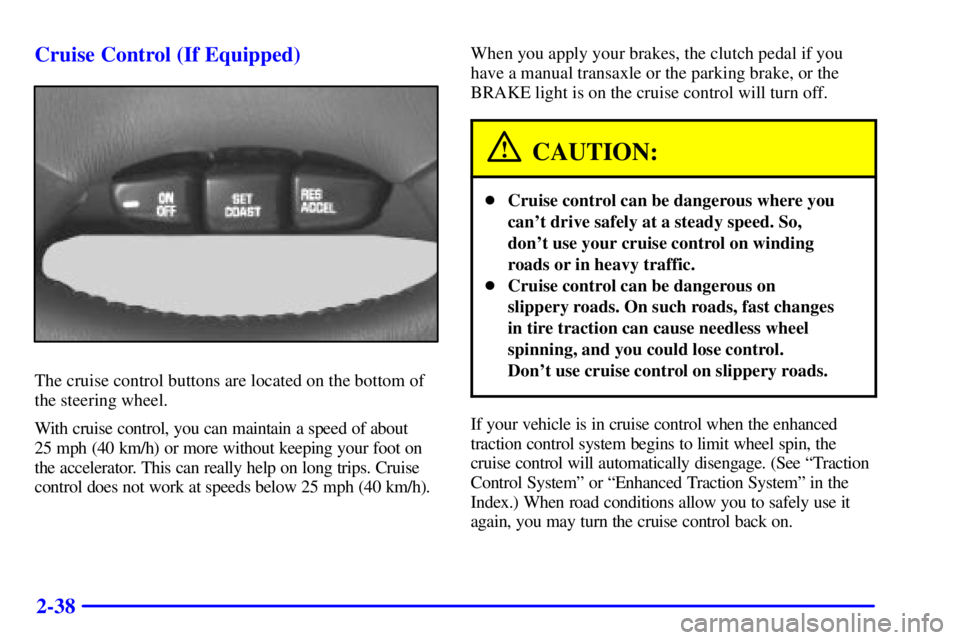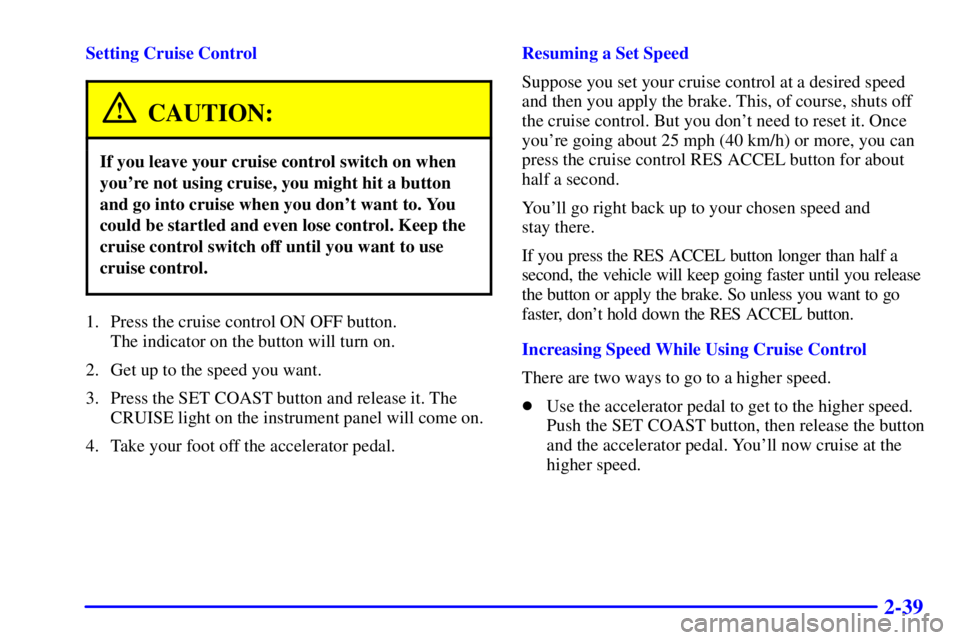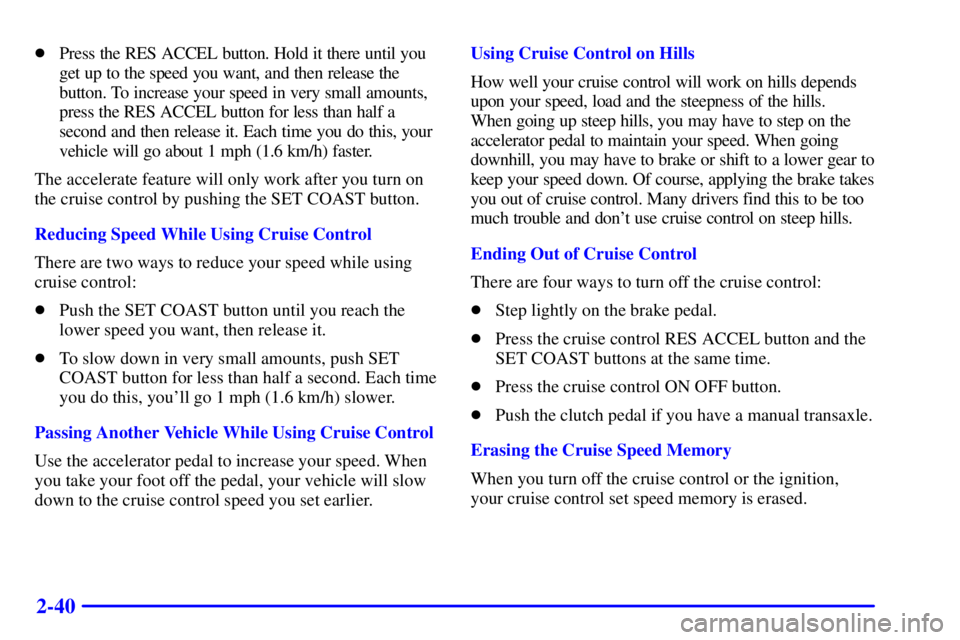Page 4 of 318
ii
Table of Contents
Keys and Door Locks
Remote Keyless Entry System
Trunk Release
Automatic Transmission (If Equipped)
Manual Transmission
Parking Brake
Windows
Tilt Wheel
Turn Signal/Multifunction LeverWindshield Wipers
Cruise Control
Interior and Exterior Lamps
Mirrors
Storage Compartments
Convenience Net (If Equipped)
Sunroof (If Equipped)
Instrument Panel, Warning Lights and Gages Seats and Seat Controls
Safety BeltsAir Bag Systems
Child Restraints
Section
1
Section
2
Seats and Restraint Systems
Features and Controls
Page 103 of 318

2-38 Cruise Control (If Equipped)
The cruise control buttons are located on the bottom of
the steering wheel.
With cruise control, you can maintain a speed of about
25 mph (40 km/h) or more without keeping your foot on
the accelerator. This can really help on long trips. Cruise
control does not work at speeds below 25 mph (40 km/h).When you apply your brakes, the clutch pedal if you
have a manual transaxle or the parking brake, or the
BRAKE light is on the cruise control will turn off.
CAUTION:
�Cruise control can be dangerous where you
can't drive safely at a steady speed. So,
don't use your cruise control on winding
roads or in heavy traffic.
�Cruise control can be dangerous on
slippery roads. On such roads, fast changes
in tire traction can cause needless wheel
spinning, and you could lose control.
Don't use cruise control on slippery roads.
If your vehicle is in cruise control when the enhanced
traction control system begins to limit wheel spin, the
cruise control will automatically disengage. (See ªTraction
Control Systemº or ªEnhanced Traction Systemº in the
Index.) When road conditions allow you to safely use it
again, you may turn the cruise control back on.
Page 104 of 318

2-39
Setting Cruise Control
CAUTION:
If you leave your cruise control switch on when
you're not using cruise, you might hit a button
and go into cruise when you don't want to. You
could be startled and even lose control. Keep the
cruise control switch off until you want to use
cruise control.
1. Press the cruise control ON OFF button.
The indicator on the button will turn on.
2. Get up to the speed you want.
3. Press the SET COAST button and release it. The
CRUISE light on the instrument panel will come on.
4. Take your foot off the accelerator pedal.Resuming a Set Speed
Suppose you set your cruise control at a desired speed
and then you apply the brake. This, of course, shuts off
the cruise control. But you don't need to reset it. Once
you're going about 25 mph (40 km/h) or more, you can
press the cruise control RES ACCEL button for about
half a second.
You'll go right back up to your chosen speed and
stay there.
If you press the RES ACCEL button longer than half a
second, the vehicle will keep going faster until you release
the button or apply the brake. So unless you want to go
faster, don't hold down the RES ACCEL button.
Increasing Speed While Using Cruise Control
There are two ways to go to a higher speed.
�Use the accelerator pedal to get to the higher speed.
Push the SET COAST button, then release the button
and the accelerator pedal. You'll now cruise at the
higher speed.
Page 105 of 318

2-40
�Press the RES ACCEL button. Hold it there until you
get up to the speed you want, and then release the
button. To increase your speed in very small amounts,
press the RES ACCEL button for less than half a
second and then release it. Each time you do this, your
vehicle will go about 1 mph (1.6 km/h) faster.
The accelerate feature will only work after you turn on
the cruise control by pushing the SET COAST button.
Reducing Speed While Using Cruise Control
There are two ways to reduce your speed while using
cruise control:
�Push the SET COAST button until you reach the
lower speed you want, then release it.
�To slow down in very small amounts, push SET
COAST button for less than half a second. Each time
you do this, you'll go 1 mph (1.6 km/h) slower.
Passing Another Vehicle While Using Cruise Control
Use the accelerator pedal to increase your speed. When
you take your foot off the pedal, your vehicle will slow
down to the cruise control speed you set earlier.Using Cruise Control on Hills
How well your cruise control will work on hills depends
upon your speed, load and the steepness of the hills.
When going up steep hills, you may have to step on the
accelerator pedal to maintain your speed. When going
downhill, you may have to brake or shift to a lower gear to
keep your speed down. Of course, applying the brake takes
you out of cruise control. Many drivers find this to be too
much trouble and don't use cruise control on steep hills.
Ending Out of Cruise Control
There are four ways to turn off the cruise control:
�Step lightly on the brake pedal.
�Press the cruise control RES ACCEL button and the
SET COAST buttons at the same time.
�Press the cruise control ON OFF button.
�Push the clutch pedal if you have a manual transaxle.
Erasing the Cruise Speed Memory
When you turn off the cruise control or the ignition,
your cruise control set speed memory is erased.
Page 116 of 318
2-51
The main components of your instrument panel are:
A. Fog Lamp Switch
B. Instrument Panel Intensity Control
C. Turn Signal/Multifunction Lever
D. Horn
E. Instrument Cluster
F. Windshield Wiper/Washer Lever
G. Ignition Switch
H. Enhanced Traction System
I. Hazard SwitchJ. Audio System
K. Climate Control System
L. Cigarette Lighter
M. Gear Shift Lever
N. Cruise Control Switches (If Equipped)
O. Steering Wheel Audio System (If Equipped)
P. Tilt Wheel Lever
Q. Hood Release Handle
R. Fuse Panel
Page 131 of 318
2-66 Cruise Light (If Equipped)
The CRUISE light comes
on whenever you set your
cruise control.
Low Washer Light
This light will come on
briefly when you turn on
the ignition.
It will also stay on, or come on and a chime will sound,
if the windshield washer fluid reservoir is less than
one
-third full.
Service Vehicle Soon Light
This light will come on
briefly when you turn
on the ignition.
It will stay on, or come on and a chime will sound if it
detects a problem on the vehicle, such as a DRL or an
ALC malfunction. If this happens, see your dealer as
soon as possible.
Page 161 of 318

4-9
Remember: Anti-lock doesn't change the time you need
to get your foot up to the brake pedal or always decrease
stopping distance. If you get too close to the vehicle in
front of you, you won't have time to apply your brakes
if that vehicle suddenly slows or stops. Always leave
enough room up ahead to stop, even though you have
anti
-lock brakes.
Using Anti
-Lock
Don't pump the brakes. Just hold the brake pedal down
firmly and let anti
-lock work for you. You may feel a
slight brake pedal pulsation or notice some noise, but
this is normal.
Braking in Emergencies
With anti-lock, you can steer and brake at the same
time. In many emergencies, steering can help you more
than even the very best braking.
Enhanced Traction System
Your vehicle is equipped with an Enhanced Traction
System (ETS) that limits wheel spin. This is especially
useful in slippery road conditions. The system operates
only if it senses that one or both of the front wheels
are spinning or beginning to lose traction. When this
happens, the system reduces engine power and may also
upshift the transaxle to limit wheel spin.
This light will come on
when your Enhanced
Traction System is limiting
wheel spin. See ªEnhanced
Traction System Active
Lightº in the Index. You
may feel or hear the system
working, but this is normal.
This light will also come on when the anti
-lock brake
system is working.
If your vehicle is in cruise control when the enhanced
traction system begins to limit wheel spin, the cruise
control will automatically disengage. When road
conditions allow you to safely use it again, you may
reengage the cruise control. (See ªCruise Controlº in
the Index.)
The Enhanced Traction System operates in all transaxle
shift lever positions. But the system can upshift the
transaxle only as high as the shift lever position you've
chosen, so you should use the lower gears only when
necessary. See ªAutomatic Transaxleº in the Index.
Page 274 of 318
6-53
Passenger's SideFuse Usage
INST LPS Interior Lamp Dimming
CRUISE
SW LPSSteering Wheel Cruise Control
Switch Lamps
CRUISE SW Steering Wheel Cruise
Control Switches
HVAC
BLOWERHVAC Blower Motor
CRUISE Cruise Control
FOG LPS Fog Lamps
INT LPS Interior Courtesy Lamps
RADIO BATT Radio
SUNROOF Power Sunroof
Circuit Breaker Usage
PWR WNDW Power Windows